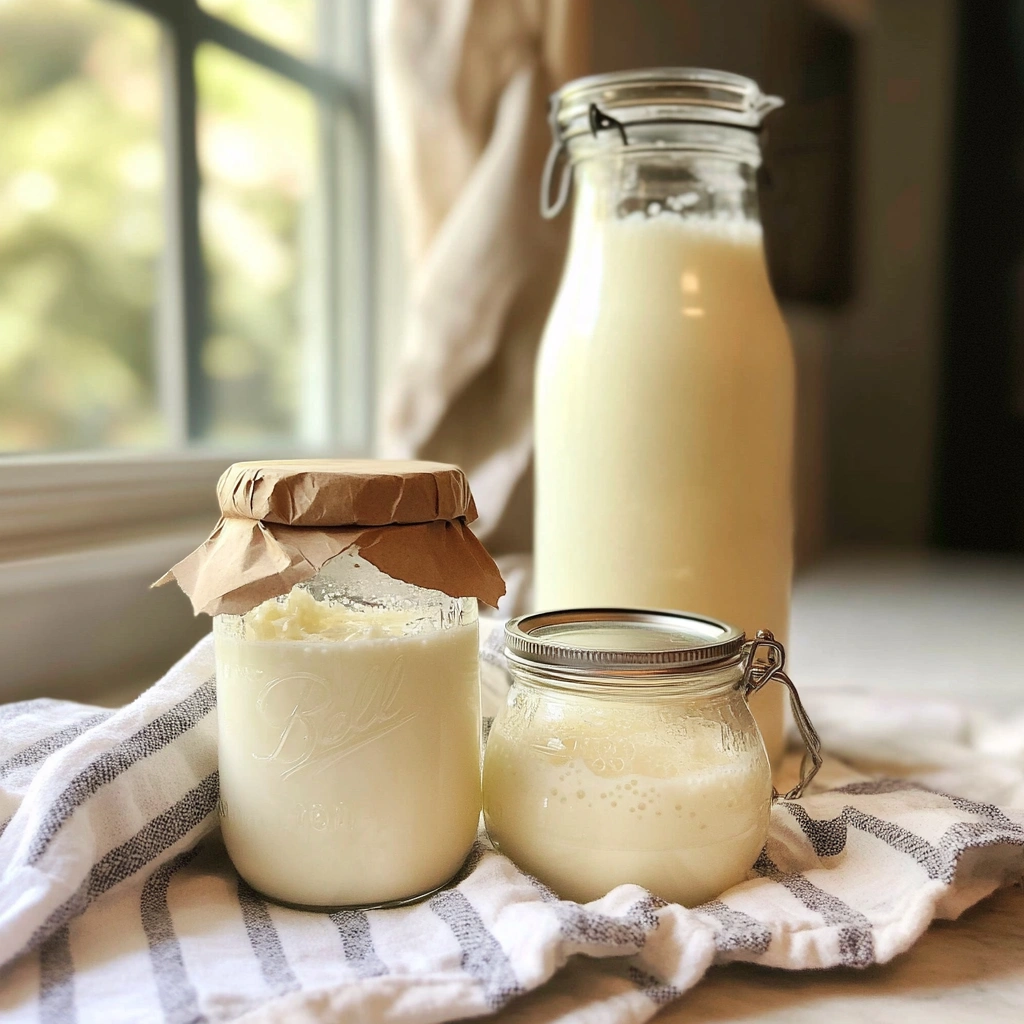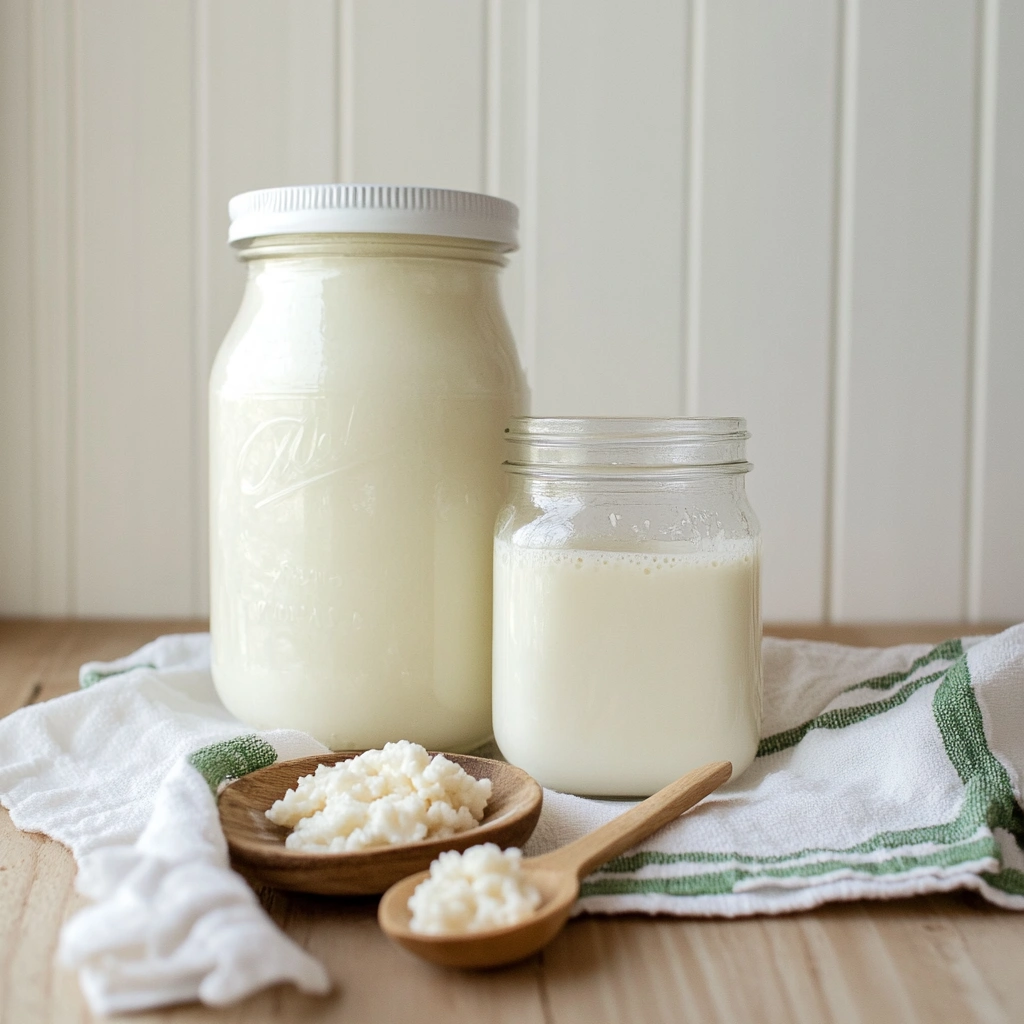Okay, let’s get real—baking isn’t just about mixing flour, butter, and eggs anymore. These days, people are getting more adventurous with their ingredients, which begs the question: Is kefir good for baking? Absolutely! If you haven’t already tried kefir in your recipes, you’re missing out. It’s not just for smoothies or that cool yogurt parfait—kefir has the potential to take your baked goods to the next level. Trust me, kefir could become your new secret ingredient.
In this blog post, we’ll chat about what kefir is, why it works so well in baking, and how you can start incorporating it into your cakes, muffins, pancakes, and so much more. By the end, you’ll be ready to make your baking a whole lot fluffier and tangier with this superstar ingredient!
What Is Kefir?
Okay, let’s start with the basics: Is kefir good for baking? To understand its potential, you first need to know what kefir is. You might’ve seen kefir bottles in the grocery store or heard your health-conscious friends rave about it, but do you know what it actually is? Simply put, kefir is a fermented dairy product, similar to yogurt but thinner and tangier. It’s made by fermenting milk with kefir grains (a mix of bacteria and yeast), which gives it that signature tart flavor and creamy texture.
Now, before you start picturing some strange science experiment, know this—kefir is packed with probiotics (the good bacteria) that are awesome for your gut health. So, while you can totally drink it straight up (or in smoothies, yum!), kefir’s real magic happens when you bring it into your baking game.
Why Is Kefir So Good for Baking?
You might be wondering, “What makes kefir so special for baking?” Well, let me break it down for you:
- Kefir Adds Tang
When you use kefir in your baking, it adds a nice, subtle tanginess that’s similar to buttermilk. This gives your cakes, muffins, and pancakes that irresistible flavor that makes people go, “What is that?!” without quite being able to pinpoint it. - It’s a Natural Leavening Agent
Kefir contains active bacteria and yeast that can react with baking soda or baking powder. This means it can help your bakes rise and get super light and fluffy. It’s like a natural version of the chemical leaveners you typically use in baking! - Moisture and Tenderness
Want your cakes to be moist without that heavy, greasy feeling? Kefir’s got you covered. Its liquid-y consistency adds moisture to your batter while keeping the final product tender. This is particularly awesome for things like muffins or quick breads where you don’t want to bite into a dense, dry piece of bread. - Nutritional Boost
Kefir is full of beneficial probiotics, calcium, and protein. So not only will it make your bakes lighter and tastier, but they’ll be healthier too. (Well, healthier than regular baked goods, at least!) - Versatility
Kefir is so versatile. It can replace milk, buttermilk, or even yogurt in most recipes, meaning you can experiment with it in nearly anything. From savory dishes like biscuits to sweet treats like cakes and pies, kefir’s got your back.

How to Use Kefir in Baking: Easy Tips & Tricks
Now that you know the answer to “Is kefir good for baking?” and why it works wonders, let’s dive into how you can actually use it. Here are some quick tips to help you incorporate kefir into your baking routine and elevate your recipes with its tangy, creamy goodness.
1. Substitute It for Buttermilk or Milk
In most recipes, you can simply swap out milk or buttermilk with kefir. The ratio is usually 1:1, so if your recipe calls for 1 cup of milk, you can use 1 cup of kefir instead.
If you want to mimic buttermilk, just add a little lemon juice to kefir before using it. This will give you that same acidity and tanginess that makes buttermilk such a star in baking.
2. Pair It with Baking Soda for Extra Lift
If you’re wondering, “Is kefir good for baking?”, here’s a key reason why it’s a fantastic ingredient: its acidity. When you use kefir to replace milk in a recipe, the acidity can activate baking soda, resulting in better leavening. This means your dough or batter will rise more, giving your baked goods a fluffier, lighter texture.
If you’re using a recipe that calls for baking powder and not baking soda, you might want to add a pinch of baking soda for that extra lift (don’t go crazy, just a little goes a long way).
3. Make Kefir-Infused Pancakes
Let’s face it, pancakes are a weekend ritual for many of us. So why not kick it up a notch? Just replace the milk in your pancake recipe with kefir for extra fluff. I’ve tried it, and trust me, the pancakes turn out light, airy, and with just the right amount of tang.
4. Kefir in Muffins, Cakes, and Quick Breads
If you’re making muffins or cakes, kefir helps keep them moist and soft. Try swapping out half of the liquid in your cake or muffin recipe with kefir. You’ll get the moisture without the heaviness, and the flavor will be subtly different in the best way possible.
5. Kefir in Cookies
Don’t sleep on kefir for cookies! It works especially well in soft-batch style cookies, giving them a chewy texture. Just replace a little bit of the butter or milk in your cookie dough with kefir, and get ready for cookies that are slightly crisp on the outside and soft on the inside.
Fun Kefir Baking Recipes You’ll Want to Try
Here are a few simple recipes where you can incorporate kefir for some next-level baking:
Kefir Pancakes
Light, fluffy, and packed with probiotics—is kefir good for baking? Absolutely! These pancakes are perfect for a lazy Sunday brunch or a special breakfast treat. Simply swap your regular milk for kefir, and you’ll end up with pancakes that are as soft as clouds and full of tangy, delicious flavor.
Kefir Banana Bread
Banana bread is a classic. But when you add kefir to the mix, you get a banana bread that’s moist, fluffy, and has just the right amount of tang. Plus, it’s a great way to use up those ripe bananas sitting on your counter.
Kefir Chocolate Chip Cookies
These cookies are everything! With a slight tang from the kefir, they’re perfectly chewy and just sweet enough. You might even find yourself sneaking a few extra bites when no one’s looking.
For a delicious way to try baking with kefir, check out this Kefir Sheet Cake Recipe—it’s easy and so good!

The Science Behind Kefir in Baking
Here’s why the answer to “Is kefir good for baking?” is a resounding yes: it’s all about the acidity and fermentation process. Kefir’s natural tanginess isn’t just a flavor enhancer—it reacts with baking soda to produce carbon dioxide bubbles, resulting in lighter, airier baked goods. This makes kefir a go-to choice for bakers who want consistently fluffy results while sticking to wholesome, minimally processed ingredients.
Plus, the proteins in kefir work a little differently than regular milk. They bind better with the starches in your batter, creating a smooth, creamy texture in the final product. So, if you’re making a bundt cake or even soft dinner rolls, kefir can take them from “just okay” to “wow, I need another slice.”
Kefir: A Natural Buttermilk Substitute
One of the main reasons bakers swear by kefir when asking, “Is kefir good for baking?”, is its ability to replace buttermilk effortlessly. Buttermilk has long been a baker’s secret weapon for adding flavor and creating a tender crumb, but let’s face it—not everyone keeps buttermilk in their fridge. That’s where kefir comes in! It offers the same acidity and moisture as buttermilk, without the need to mix vinegar or lemon juice into milk for a substitute. It’s a convenient, flavorful option that delivers perfect results every time.
And let’s talk practicality. Kefir lasts longer in the fridge than fresh buttermilk, making it a more budget-friendly and less wasteful option for occasional bakers. Plus, if you’ve ever poured buttermilk down the sink because it expired too soon, you’ll appreciate how kefir solves that problem.
Can Non-Dairy Kefir Work for Baking?
For my lactose-intolerant friends or those who prefer non-dairy options, you’ll be happy to know that non-dairy kefir can work in baking too! Made from coconut, almond, or soy milk, non-dairy kefir still has that signature tang and liquid consistency. It might not give quite the same lift as dairy-based kefir because the protein content is lower, but it still adds moisture and flavor to your baked goods.
If you’re trying a recipe with non-dairy kefir, you might want to include an extra egg or a bit more baking powder to help compensate. This will help your baked goods rise properly and hold together without losing texture.
Can Kefir Be Used in Frosting or Glazes?
When considering “Is kefir good for baking?”, don’t forget it’s not just for the batter—what goes on top matters too! Kefir is a fantastic addition to frostings or glazes, especially for cakes, cupcakes, or cinnamon rolls. Mixing kefir into a powdered sugar glaze adds a tangy twist that complements the sweetness of your treats perfectly. For frosting, swap a portion of the cream or milk with kefir to create a smoother, slightly tangy flavor that balances the richness of traditional buttercream.
Pro tip: Kefir-based frostings are perfect for summery cakes like lemon or carrot cake, where a little tanginess boosts the flavors and makes them pop.
Kefir in Gluten-Free Baking
Gluten-free baking can be a bit tricky, but kefir might just be your new best friend if you’re avoiding gluten. The natural enzymes in kefir help hydrate gluten-free flours like almond, oat, or rice flour, creating a more cohesive batter or dough. This means fewer crumbly muffins and cookies and more baked goods with a nice, chewy texture.
Is kefir good for baking? Absolutely, especially if you’re experimenting with gluten-free recipes. Try adding kefir to your next batch of cookies, pancakes, or even bread. You’ll be amazed at how much it improves the texture and flavor, all without needing additional stabilizers or gums.
Why Every Baker Should Try Kefir
Is kefir good for baking? Absolutely! Kefir isn’t just a trendy ingredient—it’s a game-changer for anyone who loves to bake. It’s incredibly versatile, easy to use, and offers countless benefits, from improving the texture of your cakes to adding a unique tang to your cookies. Whether you’re baking for a family gathering or simply whipping up a batch of muffins for the week, kefir is the secret ingredient that can elevate your baked goods to the next level.
If you’ve never used kefir before, start small—maybe swap it into your pancake or muffin recipe. Once you get the hang of it, you’ll wonder why you didn’t start baking with kefir sooner. And hey, even if your first batch doesn’t turn out perfect (we’ve all been there), you’re still getting probiotics and a whole lot of fun experimenting in the kitchen.
FAQs
Can I use kefir in all baking recipes?
You can use kefir in most baking recipes, but it works best in recipes that already call for buttermilk, milk, or yogurt. If your recipe doesn’t call for any of those ingredients, you may need to adjust the liquid ratio a bit, as kefir is thinner than yogurt or sour cream.
Can I replace kefir with regular milk or buttermilk?
Yes, you can, but you’ll lose the unique tangy flavor and the probiotic benefits kefir offers. If you’re after that subtle kefir flavor, I’d suggest sticking with it.
Does baking kill the probiotics in kefir?
Yes, unfortunately, the heat from baking does destroy the live probiotics in kefir. However, you still get all the benefits of the vitamins, minerals, and protein, and the tangy flavor remains.
Can I use kefir in savory baked goods?
Absolutely! Kefir works great in savory bakes like biscuits, scones, and even savory muffins. The acidity helps create a tender crumb, and the flavor adds a bit of a kick without being overpowering.
Conclusion
So, is kefir good for baking? Absolutely—it’s not just good; it’s a total game-changer. From its tangy flavor to its natural ability to make your baked goods rise and stay moist, kefir is one of those ingredients that deserves a spot in every baker’s fridge. Whether you’re whipping up pancakes, muffins, cookies, or even gluten-free treats, kefir brings something special to the table.
The best part? You don’t need to be a professional baker to use it. Swapping kefir into your recipes is simple and rewarding, and it can replace staples like buttermilk, yogurt, or milk with ease. Plus, the added bonus of nutritional benefits like probiotics makes it a smart choice for your baking adventures.
So next time you’re reaching for ingredients, grab a bottle of kefir and see what happens. Whether you’re baking for family, friends, or just yourself (no shame in that!), you’ll love the difference it makes. Who knows, kefir might just become your new baking BFF. Happy baking, and don’t forget to share your creations with us in the comments below!

